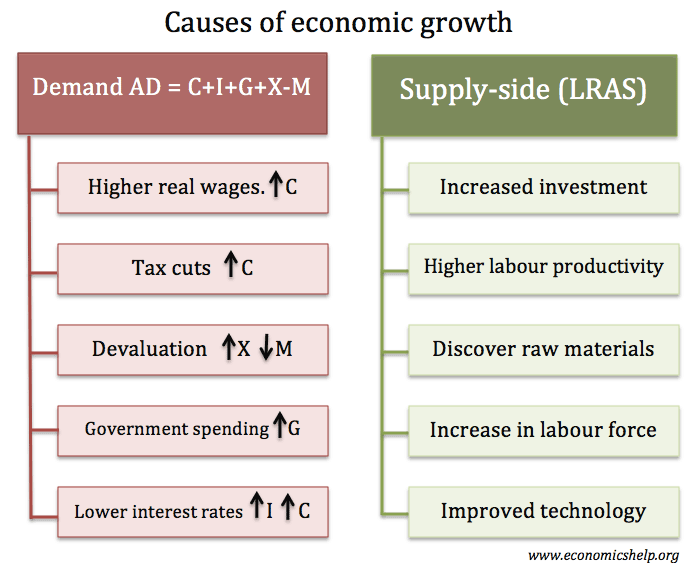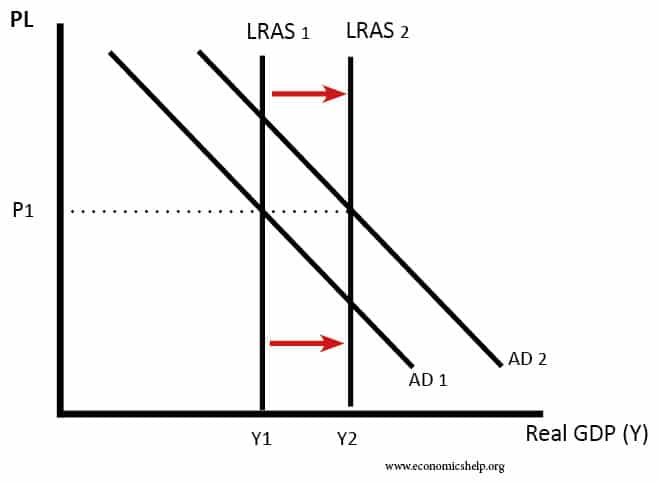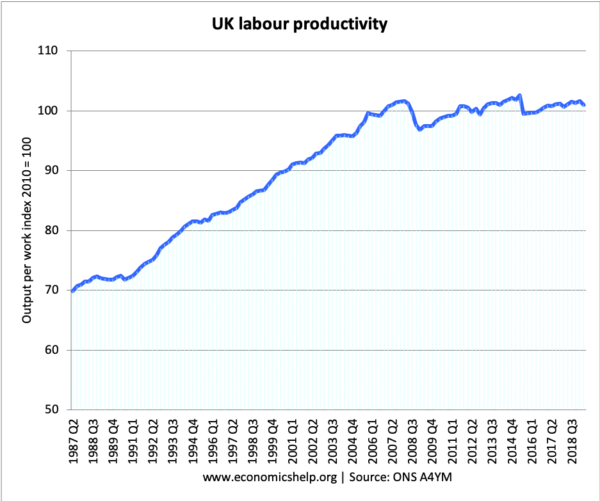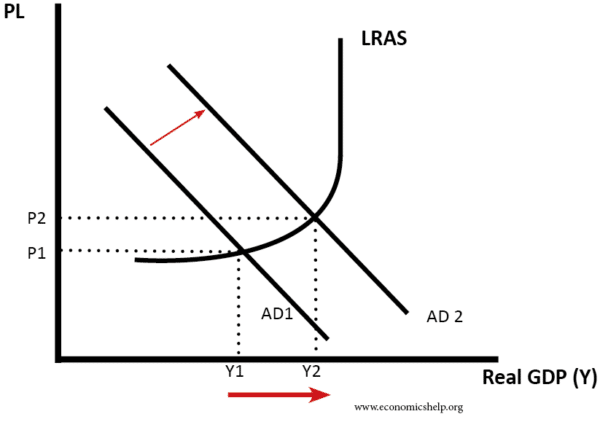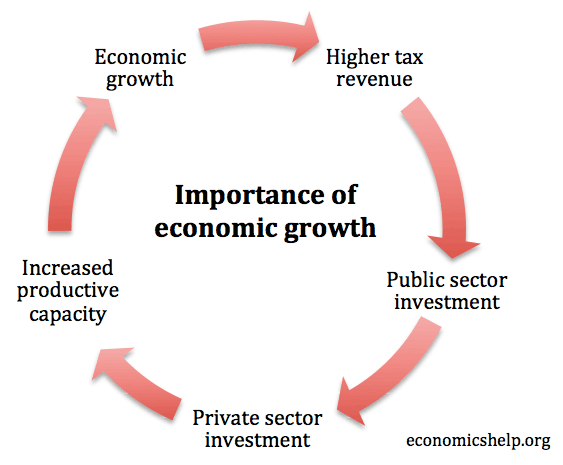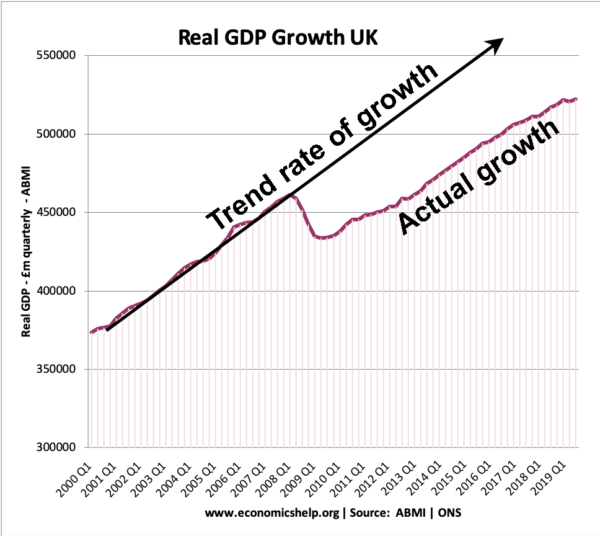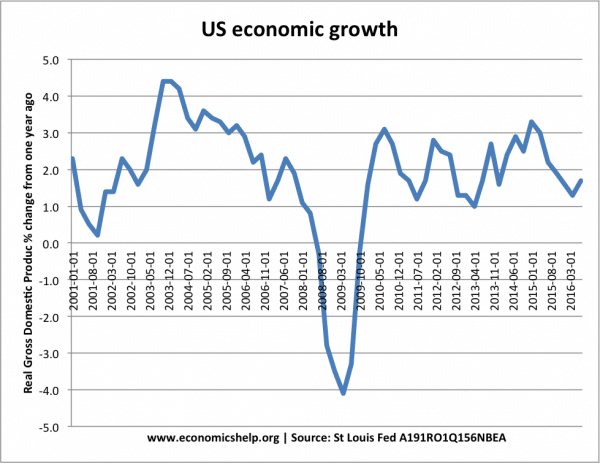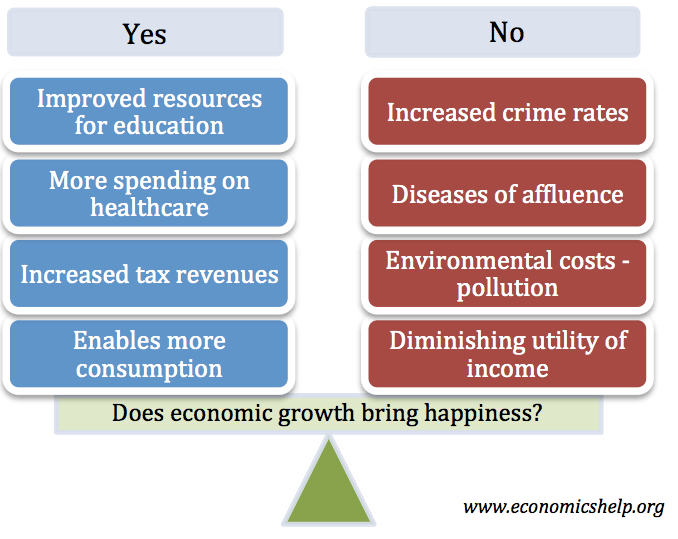Economic growth means an increase in real GDP – which means an increase in the value of national output/national expenditure.
Economic growth is an important macro-economic objective because it enables increased living standards, improved tax revenues and helps to create new jobs.
Aspects of economic growth
- Causes of economic growth
- Costs/benefits of economic growth
- Policies to improve economic growth
- Different types of economic growth
- Recessions (negative economic growth)
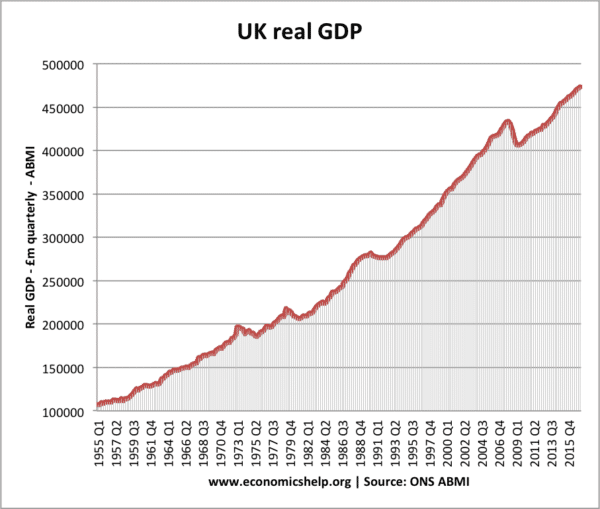
Source: ONS
Causes of economic growth
Economic growth is caused by rising demand and an increase in productive capacity.
- An increase in aggregate demand AD=(C+I+G+X-M) – a rise in consumption, investment, government spending, exports – imports.
- Increase in aggregate supply (increase in capital, investment, higher labour productivity)
- See more on the causes of economic growth
Diagram showing long-run economic growth
In this diagram, we have an increase in aggregate demand (AD) and an increase in long-run aggregate supply (LRAS). This enables a rise in real GDP – without causing inflation.
Example of economic growth
- If the Central Bank cut interest rates, this would provide an incentive for firms to invest (borrowing would now be cheaper).
- This investment is a component of AD and AD will rise. With higher investment, more people will be employed, and there is a purchase of raw materials.
- Also, the cut in interest rates will encourage consumer spending due to lower borrowing costs and lower mortgage repayments. This will cause an additional rise in AD.
- The investment will also lead to an increase in productive capacity (LRAS) with firms gaining more capacity to meet demand.
Productivity
- A key factor in enabling economic growth in the long-term is productivity. Productivity is output per worker.
- If there is the development of new technology (computers, machines), it means workers will be able to do produce more.
- This growth in output per worker is a key factor behind economic growth.
Policies to increase economic growth
Supply-side policies are government attempts to increase productivity and increase efficiency in the economy. The aim is to shift Long Run Aggregate Supply (LRAS) to the right. Examples could include:
- Income tax cuts (to increase incentives to work);
- Privatisation (Make government-owned firms private to increase the profit-incentive and efficiency.)
- Reduce red-tape and bureaucracy which raises costs for firms.
- Spending on education and training to improve labour productivity
- More on Supply-Side Policies
Reducing interest rates to stimulate economic activity and increase AD. Lower interest rates reduce the cost of borrowing. This encourages households to spend. Also, it is cheaper for firms to finance investment so investment should rise. If successful, lower interest rates should increase aggregate demand, and in the long-term, increase long-run aggregate supply.
However, lower interest rates may not always cause higher growth. If confidence is very low, firms may still be reluctant to invest.
Also, there is a limit to how much monetary policy can increase growth. If the economy is close to full capacity, then rising AD will cause inflation and the growth will be unsustainable.
See more at Monetary policy
Expansionary fiscal policy involves higher government spending and/or cutting taxes to boost aggregate demand. This fiscal policy will lead to higher government borrowing, which can be a constraint on the policy.
- Keynes was an advocate of fiscal policy in a recession. Keynes argued in a recession, the private sector increased their saving ratios and the government needed to intervene.
- However, monetarists and classical economists are more sceptical arguing expansionary fiscal policy will cause crowding out.
Benefits of economic growth
- Higher incomes for workers and firms.
- Increased tax revenue for the government which can be spent on public services, e.g. education, pensions and healthcare.
- Reduced government debt. Higher economic growth usually reduces the government’s budget deficit because of the improved tax revenues.
- Economic growth creates employment and helps to reduce unemployment.
- Economic growth creates a positive feedback loop. Higher growth encourages firms to invest. The increased investment enables higher growth in the future.
- Economic growth enables a reduction in absolute poverty. In the past 100 years, growth has helped to significantly reduce absolute poverty in Western Europe, the US and recently in Asia.
See: Benefits of economic growth
Potential costs of economic growth
- Inflation. If growth is too fast, we could experience inflation.
- Current account deficit. If growth is unbalanced, we could see a growing current account deficit as people buy more imports.
- Environmental costs. Economic growth leads to higher resource consumption and pollution.
- A decline in living standards. Economic growth does not always increase living standards. Higher growth could cause new problems such as congestion, increased crime, increased dissatisfaction and more pollution.
- See more at: Costs of Economic Growth
Types of economic growth
There are different types of economic growth
- Boom and bust economic cycles. If growth is very fast and inflationary, then the growth will prove to be unsustainable and there will be the costs of the recession and an economic downturn.
- Export-led growth. Economies such as Japan and China have experienced export-led growth. This enables economic growth and a current account surplus. China has increased its ownership of foreign assets.
- Consumer-led growth. Since 1979, UK economic growth has been more dependent on consumer spending. The UK has run a persistent current account deficit with fears the economic growth is unbalanced.
- Commodity exports. Some countries very rich in resources have economic growth based on production and export of raw materials. For example, Saudi Arabia (oil), Venezuela (oil), Cuba (sugar) Congo (oil and natural resources). Whilst export of raw materials can increase wealth, it can also cause problems. The resource curse states countries which have growth based on raw materials may struggle in long-term, as raw material industries crowd out other manufacturing industries and make the economic growth more volatile – depending on fluctuating prices.
Long-run trend rate of economic growth
The long-run trend rate is the average sustainable rate of growth over a period of time. The long-run trend rate depends on the growth of productivity and is related to levels of technology and investment.
Other Definitions
- Balanced growth – growth that is sustainable (avoiding booms and busts)
- Trade cycle – how economic growth can be cyclical – booms, busts, recovery
- Sustainable growth – growth that is balanced and environmentally sustainable.
Recessions
A recession is a period of negative economic growth, where output falls for two consecutive quarters. This graph shows the deep recession in the US economic 2008-09. (known as the Great Recession)
- See: Causes of Recessions
Does economic growth increase welfare?
Related pages

